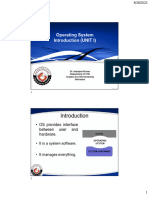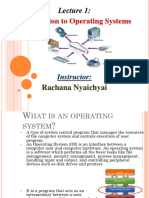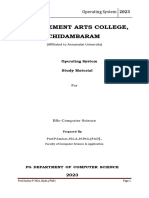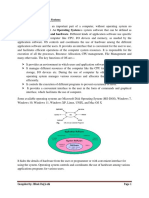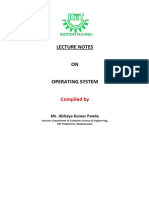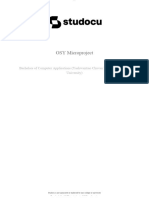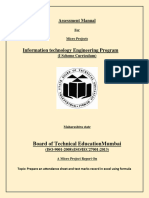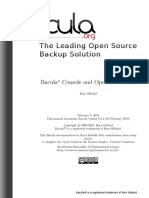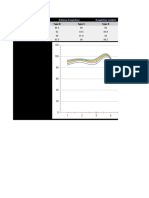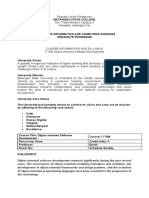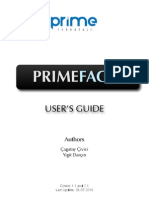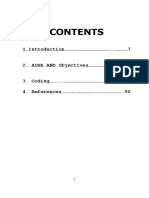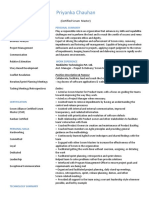24-12-2022
MAHARAJA SURAJMAL INSTITUTE
Department of Computer Applications
Unit – 2
interaction with
computer
(BCA – 105)
Mr. S.P. Chauhan
Asst. Prof. & Hostel Warden
S.P. Chauhan 1
Operating Systems
An operating system (OS) is a collection of system programs that together controls the
operation of a computer system. Operating system along with hardware, application, other
system software and users constitute a computer system.
i.e. operating system is a collection of programs that control the operation of all the hardware
components and various other resources in a computer. It is responsible for smooth and
efficient operation of the computer and controls the CPU, memory, I/O devices.
Basically it acts an intermediator between the user of a computer and the computer hardware,
whose over all purpose is to provide an environment which is convenient for a user to execute
program or to perform tasks. So the operating system has basically following two objectives:
i. Managing hardware/resources:-
The OS manages and control various hardware/resources of a computer system such as
processor, memory, disk space, I/O devices etc. It also supervise which input device’s data
are requesting for being processed and which processed data are ready to be displayed on
the output devices. It communicate with hardware devices and provide error handling
procedure also displayed error notification if device is not functioning properly.
S.P. Chauhan 2
1
� 24-12-2022
Operating Systems
ii. Provide an interface:-
The OS organizes application so that user can easily access, use and store them. When
application is opened, the OS assists the application to provide the major part of the user
interface. It provides a stable and consistent way for application to deal with the hardware
without the user having to know all the details of the hardware. If application program is
not functioning properly, operating system again takes control, stop the application and
display the appropriate message.
The efficiency of the operating system and overall performance of computer system is
measured following factors:
a. Turnaround Time:-
It is the time interval from the time when user submit the job to the system for processing to
the time of the completion of the job i.e. receives the result.
b. Throughput:-
It is the amount of work performed by a system in a given period of time i.e. the amount of
work done per unit time.
c. Response Time:-
It is the time interval between the time of submission of job to the system for processing
and the time of first response from the system for the job. S.P. Chauhan 3
Operating Systems
Main Functions of Operating Systems:-
Most of the operating system perform the following functions:
i. Process Management:-
A process is a program in its execution state. During execution, a process needs certain
resources such as CPU, memory, files & I/O devices. At a particular time there can be a
number of processes in computer system. So process management module take care of
creation and deletion of processes, scheduling of different resources to different processes
requesting them and providing mechanism for synchronization and communication among
processes.
ii. Memory Management:-
To execute a program, it must be loaded in memory (may be partially) with the required
data. To improve CPU utilization and better response time, a computer system may have
several programs in main memory. So memory management module of OS take care of
allocation & deallocation of memory space as required by various programs.
iii.File Management:-
Computer system store, retrieve & share information. Normally a computer stores such
information in units called files. The OS takes care of file related activities such as
organization, storing, retrieval, naming, sharing and protection of files. S.P. Chauhan 4
2
� 24-12-2022
Operating Systems
Main Functions of Operating Systems:-
iv.Device Management:-
OS manages all the I/O devices. It keeps track of requests of processes of I/O devices,
issues commands to the I/O devices and ensure that correct data transmission to and from
I/O devices takes place.
v. Security & Protection:-
Computer store large amount of data, some of which may be highly sensitive & valuable.
The security module of OS protect the resources and information against destruction and
unauthorized access.
vi.Job Sequencing:-
OS helps in automatic job sequencing. It is the duty of OS to ensure that job entered in the
computer are executed automatically in the provided sequence.
vii.Resource Allocation:-
The Operating System ensures the proper use of all the resources available by deciding
which resource to be used by whom for how much time. All the decisions are taken by the
Operating System.
S.P. Chauhan 5
Operating Systems
Main Functions of Operating Systems:-
viii. Security:-
The operating system uses password protection to protect user data and similar other
techniques. it also prevents unauthorized access to programs and user data. .
ix. It acts as an interface between hardware and the user. It
facilitates easy communication between the computer
and the user, as this interface consists of a set of
commands or menus through which a user communicate
with program.
S.P. Chauhan 6
3
� 24-12-2022
Types of Operating Systems
As operating system perform tasks serially or concurrently. Thus resources of computer
system may be allocated to multiple programs. So the operating systems may be categorized
as follows:
1.Batch Processing System:-
In batch processing system the number of jobs are stacked one after the another
depending upon the nature of job. To speedup the process of execution, job with similar
requirements were batched together for execution. These jobs were finally handed over to
the system where operating system transferred them from one job to another. The
computer automatically process program and data of each user one after other at the same
time without intervention of operator or user. The result received in printed manner and
were handed over to the appropriate user later on. This technique was called batch
processing.
Thus batch processing is one of the oldest method of running programs. It was a serial,
sequential method in which programs were stacked one over the another and submitted to
the computer off line.
Batch processing mechanism helped in reducing idle time of computer system because
job-to-job transaction did not require any operator intervention. But how a computer
separate one job from another from a batch of jobs for automatic job-to-job transaction. i.e.
how does the system know which compiler or hardware devices is required for the
execution of job. S.P. Chauhan 7
Types of Operating Systems
1. Batch Processing System:-
To facilitate all these, the concept of control statement & job control language (JCL) was
introduced. Operating system uses it to identify a new job and to determine the resources
needed by it during its execution. Hence each job in batch processing system has program,
data and set of JCL instructions, which instruct the operating system to identify the job &
its requirements. Eg.
$ FTN – To execute FORTRAN compiler
$ASM – Execute the assembler
$RUN – Execute the user program
$JOB – Start of job i.e. First card of job
$END – End of job i.e. Last card of job.
Such operating systems were also called Resident Monitor.
Advantages:-
a. Reduce idle time of a computer as transaction from one job to another does not require
operator intervention
b. Increase performance as it was possible to start next job as previous finished.
S.P. Chauhan 8
4
� 24-12-2022
Types of Operating Systems
1. Batch Processing System:-
Disadvantages:-
a. As CPU is very fast device as compared electromechanical I/O devices, so result received
with delay. ( CPU can execute thousands of instructions per second where a card reader
may read 1200 cards per minute).
b. Large time is required to accumulate data in batches.
c. More difficult to debug the program.
d. It is difficult to provide priority scheduling.
e. One batch job can affect pending jobs.
S.P. Chauhan 9
Types of Operating Systems
2. Single User & Single Task Operating System:-
This operating system is made for single user machine i.e. Only one user can use
the machine at a time to perform a single task and operating system is available to
the single user at a time. Using this operating system only one program can be
executed at a time. eg. If user is editing a document then user can neither listen
music nor can print simultaneously.
These operating systems were designed to manage one task at a time. Eg MS–DOS.
3. Multi User Operating System:-
This operating system is made for sharable machine i.e. Data from one machine
can be shared by many users at other machine and vice versa i.e. Same application
can be accessed by multiple users at the same time. The users can also
communicate with each other eg. Linux, unix.
S.P. Chauhan 10
5
� 24-12-2022
Types of Operating Systems
4. Multiprogramming:-
As in batch processing number of programs were loaded in a sequence & program
remains occupant of CPU/ memory until the complete execution of program. This
leads the under utilization of system resources such as CPU and main memory. To
overcome this problem concept of multiprogramming was introduced.
Multiprogramming refers to execution of two or more different and independent
programs by the same computer. In this two or more programs reside in main memory
and execute concurrently. This is done by switching the CPU from one program to
another almost instantaneously. i.e. multiprogramming is a technique to execute number
of programs simultaneously by a single processor. In multiprogramming number of
processes reside in main memory at a time and OS picks and begin to execute one of the
jobs in the main memory.
In multi programming OS, when one program during execution needs I/O, the CPU
switches to other program and start its execution. Thus it makes several users to share
the time of CPU. If at some point of time the program which is executing in CPU needs
I/O and previous program I/O is completed, the CPU may start executing the previous
program which it left previously. But at one time only one program has control of CPU.
This way of execution of is called interleaved execution. S.P. Chauhan 11
Types of Operating Systems
4. Multiprogramming:-
So multiprogramming does not mean
execution of instruction from several
programs simultaneously, but it means that
multiple programs are available to CPU i.e.
stored in memory and a portion of one is
executed then a portion of another and so on.
Some multiprogramming system process
only a fixed number of jobs concurrently
called multiprogramming with fixed task
(MFT).
Others can process variable number of jobs concurrently called multiprogramming
with variable tasks (MVT).
Advantages:-
a. Throughput of the system increased as idle time of CPU is utilized.
b. Response time can also reduced by recognizing the priority of job.
S.P. Chauhan 12
6
� 24-12-2022
4.Multiprogramming:- Types of Operating Systems
Disadvantages:-
a. Memory protection mechanism is required to prevent the program from addressing
beyond the limit of its own allocated storage area.
b. Proper overlapping of the operations of CPU and I/O devices is required, so that one of
the program which doesn’t need I/O is always available to the CPU for processing.
c. Large amount of memory is required to accommodate multiple number of programs.
5.Multitasking:-
It is a single user variation of multiprogramming concept. In multitasking more than one
process (task) can be executed concurrently in interleaved fashion i.e. CPU is switched
rapidly between the processes. Hence a user can have more than one process running at a
time. Eg. A user can use word processor and audio running at the same time. The
multitasking operating system allow the user to switch the CPU between the running
applications and even transfer data between them. Eg. A user can copy the image from
internet opened in the browser application and past it into an image editing application.
So difference between multiprogramming & multitasking is that multiprogramming is
interleaved execution of multiple jobs of same or different user in multiuser environment,
while multitasking is interleaved execution of multiple jobs of same user in single user
system S.P. Chauhan 13
Types of Operating Systems
6. Multiprocessor Operating System:-
It can incorporate more than one processors dedicated to the running processes i.e.
Multiple processors can execute multiple processes concurrently. These systems use
multiple processors (CPU) to process either instructions from different and
independent programs or different instructions from the same program
simultaneously. The different CPU inside a computer system may either have the
common memory (tightly coupled) or separate memories (loosely coupled). The
basic organization of multiprocessing is shown in fig.
There are two types of multiprocessing systems:
i. Symmetrical Multiprocessing System:-
In this system all processors are of same type
and performs the same function. In this system,
every processor owns a similar copy of the OS,
and they can make communication in between
one another. i.e. meaning it won’t be using
master & slave relation.
S.P. Chauhan 14
7
� 24-12-2022
Types of Operating Systems
6. Multiprocessor Operating System:-
ii.Asymmetric Multiprocessing System:-
In this system all processors are not of same type i.e. there is some difference between
processors. In such system one processor control the rest processors i.e. it is the supervisors
of the others.
Every processor in this operating system is given seeded tasks, and the master processor has
the power for running the entire system. In the course, it uses the master-slave relationship.
Advantages:-
a. Improve the performance by allowing parallel processing of segments of programs.
Thus it results in increased throughput and lower turnaround time.
b. Provide backups, if one CPU fails other CPU is brought into use. Thus complete break
down is rare.
c. Help in proper utilization of other devices.
Disadvantages:-
a. Large amount of main memory required.
b. Sophisticated OS is required to handle the processing of multiple CPU’s
c. Use of multiple CPU’s makes it very expensive. S.P. Chauhan 15
Types of Operating Systems
7. Time Sharing Operating System:-
In time sharing operating system allocation of computer resources is done in time dependent
fashion to several programs or users simultaneously. In other words, time sharing refers to
the allocation of computer resources in time slots to several programs simultaneously thus
each users feel that they are exclusive owner of the CPU, thus each user is given a brief share
of CPU time.
In time sharing operating system multiprogramming
features allow multiple users program to reside in main
memory and CPU scheduling algorithm allocates a
short period of time one-by-one to each process from
first to last one and then again beginning from first one.
This short period during which a user gets to use CPU
is known as time slice/ time slot/ quantum and it is
typically of the order of 10 to 100 milliseconds. Hence
when the operating system allocates CPU to a user
process, the process use the CPU until its time slice
expire or it needs to perform some I/O operation or
complete its execution during this period.
S.P. Chauhan 16
8
� 24-12-2022
Types of Operating Systems
7. Time Sharing Operating System:-
Advantages:-
a. Effective utilization & sharing of the resources, such as: main memory, disk
storage, CPU is fully utilized and shared by different users.
b. Reduce CPU idle time. As CPU is busy most of the time bcz it switches from one
program to another. This increases throughput & lowers turnaround time and
response time.
c. As time slice is of few milliseconds so users can get the output of programs
quickly.
Disadvantages:-
a. Security and integrity of users programs & data may not be maintained as large
number of users access the system simultaneously.
b. As regular swapping need to be done, so when large number of users are
accessing the CPU then overhead may be involved. This may result in poor
response.
S.P. Chauhan 17
Types of Operating Systems
8. Real Time Operating System (RTOS):-
Real-time operating system used for a real-time application i.e. for those
applications where data processing should be done in the fixed and small quantum
of time. It is different from general purpose operating system where time concept is
not considered as much crucial as in Real-Time operating system.
Real time Operating Systems are very fast and quick respondent systems. These
systems are used in an environment where a large number of events (generally
external) must be accepted and processed in a short time. Real time processing
requires quick transaction and characterized by supplying immediate response.
RTOS is a time-sharing system based on clock interrupts. RTOS used Priority to
execute the process. When a high priority process enters in system low priority
process preempted to serve higher priority process.
RTOS are used in traffic signal, Nuclear reactors to control scientific experiments,
medical imaging systems, industrial system, fuel injection system, home appliance
are some application of Real Time operating system
S.P. Chauhan 18
9
� 24-12-2022
Types of Operating Systems
8. Real Time Operating System (RTOS):-
Real Time Operating Systems are categorized in two types: Hard Real Time
Operating Systems and soft Real Time Operating Systems.
Hard Real Time Operating Systems necessarily perform the task within the given
specified deadline. The tasks in HRTS are governed by rigid time constraints. When
the deadlines are relaxed, Real Time System is called Soft Real Time System. Tasks in
SRTS do not have rigid time constraints.
S.P. Chauhan 19
10


